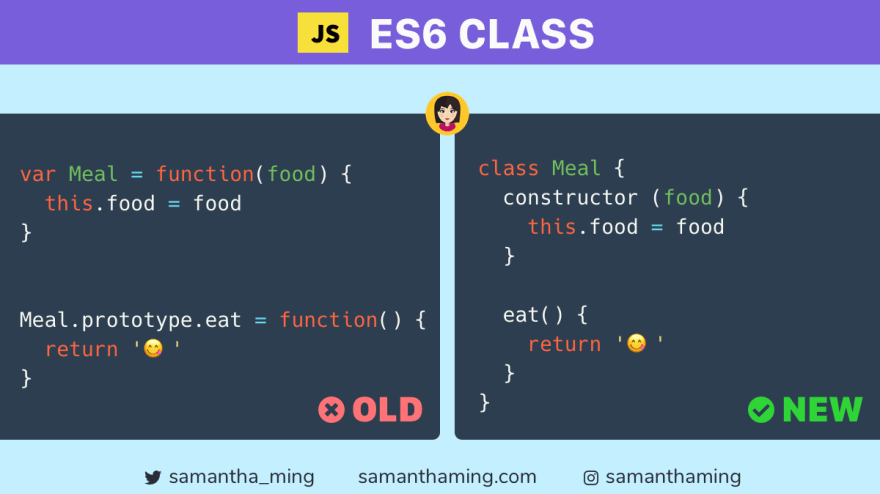An Interest In:
Web News this Week
- April 1, 2024
- March 31, 2024
- March 30, 2024
- March 29, 2024
- March 28, 2024
- March 27, 2024
- March 26, 2024
Classes in JavaScript
When I say ES6 Classes, you might go YAY JS finally introduced a new object-oriented inheritance model. Well, not exactly. Its still using the existing prototype-based inheritance (labeled as Old in the photo). But now it just looks more like Object Oriented Programming (OOP). Yay, I think this syntactical sugar is GREAT!
// Old wayvar Meal = function(food) { this.food = food;};Meal.prototype.eat = function() { return '';};// Classes in ES6class Meal { constructor(food) { this.food = food; } eat() { return ''; }}Defining a Class
For those coming from Object-Oriented Programming, then you're good. But for those new to this or just want a friendly reminder. The first step is to create our class. The keyword to use is class.
class Meal { constructor(food) { this.food = food; } // Prototype Method eat() { return ''; } // Static Method static utensil() { return ''; }}Constructor: This is a special method for initializing an instance of that class. So what that means is that whenever we create a new instance of the class, it will invoke the constructor. This is a great place to set some properties and assign parameters. For our example, we want to make sure when someone creates a new Meal instance, they have a costume in place.
Prototype Method: A prototype method is a method that is only accessible when you create an instance of the class. This will be clear when I show you an example later.
Static Method: A static method is something you can call without instantiating the class. More on this later.
Create a Class Instance
Great, now you created the class. Let's create an instance of it using the new keyword.
class Meal { ... }const dumpling = new Meal('');Now we can call our prototype method:
dumpling.eat();// '' But! you can't access static methods.
dumpling.utensil();// TypeErrorThat's because static methods are not accessible by the instance. It can only be called by the class
Meal.utensil();// ''Static vs Instance Methods
So you must be wondering when you should use a static or instance methods. Here's a very simple answer. Use static methods when you don't want to create an instance of the class. Lol, I know that's not a very satisfactory answer. Most of the time, you will see static methods used for creating utility functions for an application. Any other time, it's better to stick with an instance method.
No Arrow Function
Another cool thing ES6 introduced is Arrow Function
MDN: An arrow function expression is a syntactically compact alternative to a regular function expression, although without its own bindings to the this, arguments, super, or new.target keywords. Arrow function expressions are ill suited as methods, and they cannot be used as constructors.
Arrow Function has No Prototype Property
So in the non-sugar way, notice we used the function keyword:
var Meal = function(food) { this.food = food;};Meal.prototype.eat = function() { // <-- No Arrow Function return '';};The arrow function does not have a prototype property, so we can not use the arrow function.
// Meal.prototype.eat = () => '';Meal.prototype; // undefinedArrow Function has No New Operator
Second thing, arrow functions can't be used as constructors.
// const Meal = () => {}cont rawChicken = new Meal()// TypeError: Meal is not a constructorSo here's another one where you should use the regular function syntax.
// const Meal = function(){}cont cookedChicken = new Meal()Sugar is bad for you!
Some of you may argue that class is bad because it obscures the true nature of JS. And I think that is absolutely a fair point. Let's peel back at the intention of classes. It was introduced to make JavaScript easier to pick up
For those coming from an object-oriented programming language such as Ruby or Python, this will make the transition of learning JS a lot easier because of the familiar syntax. For newcomers, this will mean it's faster to ramped up and ready to go. And once you get going, hopefully, you will be encouraged to dive deeper into the JS and learn what's actually under the hood
But a spoonful of sugar makes the medicine go down...
Learning a new language is hard, so if we can make this process a bit easier, I think that's a great thing. It's very easy to be overwhelmed when everything is thrown at you. It's like trying to drink from a fire hose, you end up drinking no water at all. That's why tutorials are done by steps. No one goes from a white belt to a black belt right away. You have to go through the process, it requires time.
So should you employ class? -- well that depends on you and your team. Like I always say, there is never a right way; the right way is always it depends Let's not immediately dismiss "sugar" as bad. As developers, we should always keep an open mind to new ideas. Less judgment, more listening, and assume good intentions
Resources
- MDN Web Docs: Classes
- w3schools: Classes
- Arrow Function No No
- Understanding Classes in JavaScript
- ExporingJS: Classes
- The Complete Guide to JavaScript Classes
- EloquentJS: Objects
Thanks for reading
To find more code tidbits, please visit samanthaming.com
Original Link: https://dev.to/samanthaming/classes-in-javascript-30n8
Dev To
 An online community for sharing and discovering great ideas, having debates, and making friends
An online community for sharing and discovering great ideas, having debates, and making friendsMore About this Source Visit Dev To


